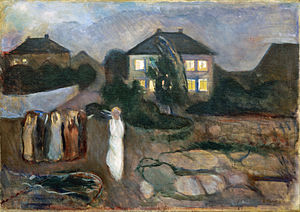The storm (Munch)

|
| The storm |
|---|
| Edvard Munch , 1893 |
| Oil on canvas |
| 91.5 x 131 cm |
| Museum of Modern Art , New York |
The storm (Norwegian: Stormen ) is a painting by the Norwegian painter Edvard Munch . It was created in Åsgårdstrand in 1893 and is based on a real storm that occurred in the area in the summer.
Image description
In the reddish blue twilight of a Nordic summer night there is a strong storm under which the trees bend to the left. The house behind is brightly lit, the yellow paint has been partially scraped off to increase the brightness. On the beach in the foreground is a group of women in different colored dresses, whose bodies are only indicated in a sketch. Slightly to the left of the center, a single woman in a white dress has left the group and is moving on towards the pier . All women have their hands pressed against their ears to protect themselves from the storm.
interpretation
According to Ulrich Bischoff , Munch created a dramatic portrayal of nature in Der Sturm from the naturalistic components storm, group of people and the beach at Åsgårdstrand, which can easily be identified as the location of the action, which becomes a landscape of the soul. Outwardly, it illustrates the contrast between the safe, brightly lit house that the women have left and the raging forces of nature in the dark night. The gesture of the women is not only protection against the storm, it is also an expression of an inner tension. In a figurative sense, it symbolizes the constitution of a society that, like in Henrik Ibsen's dramas, is extremely tense and threatened to explode.
For the contemporary critic Willy Pastor , Munch used “a certain process in Der Sturm to depict the threatening, oppressive aspects of a powerful process.” The scenery is plunged into the darkness of the night so that the characters do not come out and their expressions do not speak: “the Sturm and his powerful natural language are the essentials. ”The painting is a symbol that, like abstract art, expresses a single aspect of human experience and feeling through an emotive symbol.
Ann Temkin, the curator of MoMa, emphasizes the contrast between the closed group of five or six women and the isolated figure standing in isolation. She sees this as an expression of Munch's own feelings as an artist who is outside of society. The gesture of the women pressing their hands against their ears involuntarily reminds them of that in Munch's famous painting The Scream , which was painted in the same year. Bischoff also sees the wife of the sexless figure in Der Schrei as related. The woman in the white dress also reappears in other central works by Munch, such as The Woman in Three Stages , The Dance of Life and the Reinhardt Frieze .
The Scream (1893, Norwegian National Gallery, Oslo)
The Dance of Life (1899/1900, Norwegian National Gallery, Oslo)
Passion (Reinhardt-Fries, 1906/07, Munch Museum Oslo )
background
Jens Thiis, who later became director of the Norwegian National Gallery in Oslo , reported in his memoir that Munch's painting The Tempest was preceded by an actual event. Thiis had spent the summer in Åsgårdstrand , a popular summer retreat for the people of the Norwegian capital. He resided in the hotel that can be seen with illuminated windows in the background. After a sunny late summer day, a thunderstorm suddenly approached. A group of local women gathered on the beach to look for their husbands trying to reach the shore in their fishing boats. According to Thiis, the woman in the white dress was his future wife Ragna Vilhelmine Dons. Munch recorded what happened the following day in his painting.
Donald W. Olson, an astrophysicist at Texas State University , found that a storm that matched the descriptions had occurred at Åsgårdstrand on the evening of August 19, 1893. The bright star in the sky of the picture, which he identified as Arcturus , the main star in the bear guardian , confirms that the storm must have occurred around 9 p.m. This star is missing in some reproductions of the image because image processing programs have eliminated the white spot as an image defect.
The picture, which was in the possession of the H. Irgens Larsen couple, was donated to the Museum of Modern Art in New York in 1974 . According to Ulrich Bischoff, it is less well known in Europe.
literature
- Ulrich Bischoff : Edvard Munch . Taschen, Cologne 1988, ISBN 3-8228-0240-9 , pp. 38-39.
- Donald W. Olson: Celestial Sleuth. Using Astronomy to Solve Misteries in Art, History and Literature. Springer, New York 2013, ISBN 978-1-4614-8402-8 , pp. 94-97.
Web links
- The Storm at the Museum of Modern Art .
Individual evidence
- ↑ a b c The Storm at the Museum of Modern Art .
- ↑ a b c Ulrich Bischoff: Edvard Munch . Taschen, Cologne 1988, ISBN 3-8228-0240-9 , p. 38.
- ↑ Reinhold Heller: Edvard Munch. Life and work . Prestel, Munich 1993. ISBN 3-7913-1301-0 , p. 76.
- ^ Ulrich Bischoff: Edvard Munch . Taschen, Cologne 1988, ISBN 3-8228-0240-9 , pp. 38-39.
- ↑ Donald W. Olson: Celestial Sleuth. Using Astronomy to Solve Misteries in Art, History and Literature. Springer, New York 2013, ISBN 978-1-4614-8402-8 , pp. 94-95.
- ↑ Donald W. Olson: Celestial Sleuth. Using Astronomy to Solve Misteries in Art, History and Literature. Springer, New York 2013, ISBN 978-1-4614-8402-8 , pp. 95-97.



